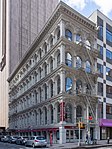Old Broadway Theatre

The Broadway Theatre (September 27, 1847 – April 2, 1859), called the Old Broadway Theatre since its demise, was at 326–30 Broadway, between Pearl and Anthony (now Worth) Streets in Lower Manhattan, New York City. With over 4000 seats, it was the largest theater ever built in New York when it opened. During its brief existence, many prominent performers of the era appeared on its stage. It presented plays, opera, ballet, hippodrama, and circus performances in a space that was reconfigured several times. The operators always struggled to make money, however, and after twelve years the Broadway Theatre was replaced by a more profitable building, for the textile trade.
Excerpt from the Wikipedia article Old Broadway Theatre (License: CC BY-SA 3.0, Authors, Images).Old Broadway Theatre
Lafayette Plaza, New York Manhattan
Geographical coordinates (GPS) Address Nearby Places Show on map
Geographical coordinates (GPS)
| Latitude | Longitude |
|---|---|
| N 40.7158 ° | E -74.0045 ° |
Address
Lafayette Plaza 26
10007 New York, Manhattan
New York, United States
Open on Google Maps







